PEUGEOT 4008 2014.5 Owners Manual
Manufacturer: PEUGEOT, Model Year: 2014.5, Model line: 4008, Model: PEUGEOT 4008 2014.5Pages: 389, PDF Size: 15.75 MB
Page 141 of 389
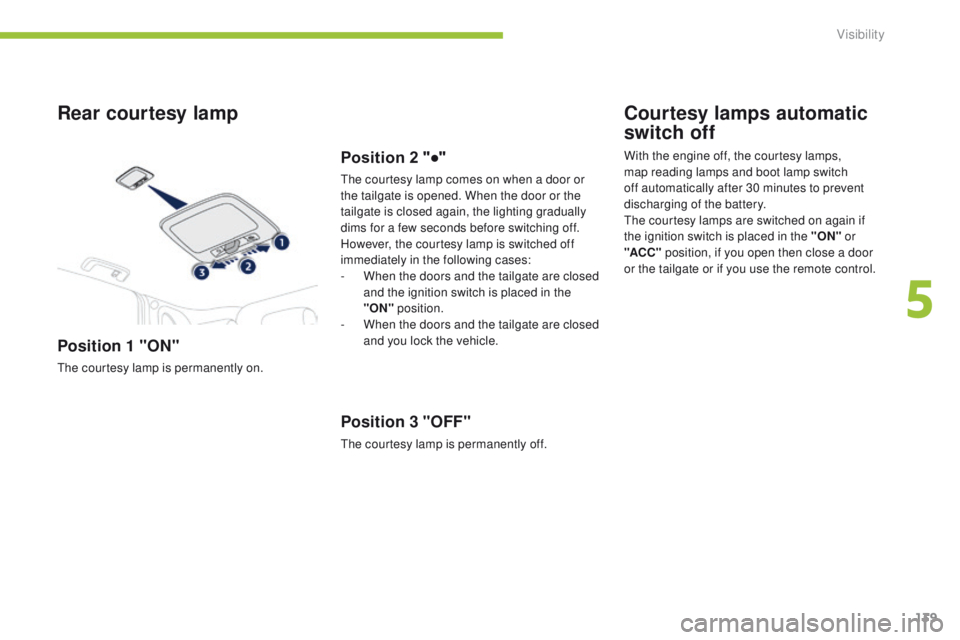
139
Rear courtesy lamp
Position 1 "ON"
the courtesy lamp is permanently on.
Position 2 "●"
the courtesy lamp comes on when a door or
the tailgate is opened. When the door or the
tailgate is closed again, the lighting gradually
dims for a few seconds before switching off.
However, the courtesy lamp is switched off
immediately in the following cases:
-
W
hen the doors and the tailgate are closed
and the ignition switch is placed in the
"ON" position.
-
W
hen the doors and the tailgate are closed
and you lock the vehicle.
Position 3 "OFF"
the courtesy lamp is permanently off.
Courtesy lamps automatic
switch off
With the engine off, the courtesy lamps,
map reading lamps and boot lamp switch
off automatically after 30 minutes to prevent
discharging of the battery.
th
e courtesy lamps are switched on again if
the ignition switch is placed in the "ON" or
"ACC " position, if you open then close a door
or the tailgate or if you use the remote control.
5
Visibility
Page 142 of 389
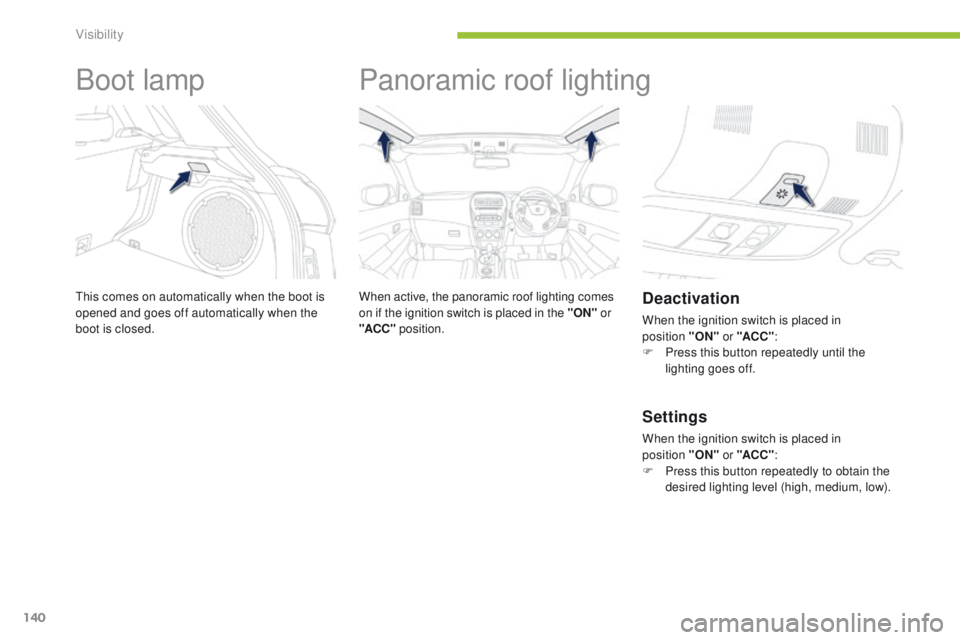
140
Boot lamp
this comes on automatically when the boot is
opened and goes off automatically when the
boot is closed.
Panoramic roof lighting
When active, the panoramic roof lighting comes
on if the ignition switch is placed in the "ON" or
"ACC " position.Deactivation
When the ignition switch is placed in
position "ON" or "ACC ":
F
P
ress this button repeatedly until the
lighting goes off.
Settings
When the ignition switch is placed in
position "ON" or "ACC ":
F
P
ress this button repeatedly to obtain the
desired lighting level (high, medium, low).
Visibility
Page 143 of 389
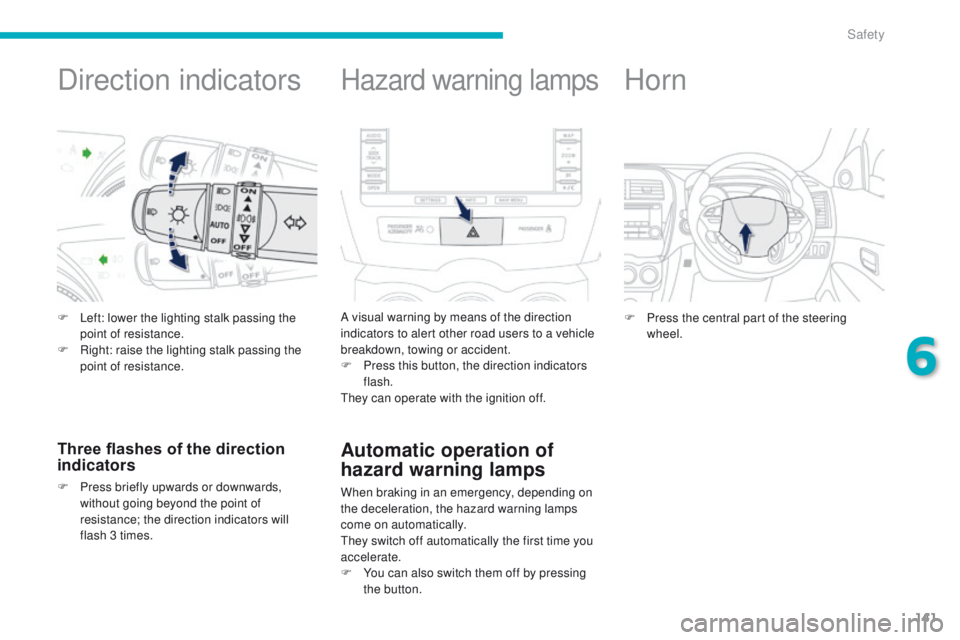
141
Direction indicators
F Left: lower the lighting stalk passing the point of resistance.
F
R
ight: raise the lighting stalk passing the
point of resistance.
Three flashes of the direction
indicators
F Press briefly upwards or downwards, without going beyond the point of
resistance; the direction indicators will
flash 3 times.
Hazard warning lamps
A visual warning by means of the direction
indicators to alert other road users to a vehicle
breakdown, towing or accident.
F
P
ress this button, the direction indicators
flash.
th
ey can operate with the ignition off.
Automatic operation of
hazard warning lamps
When braking in an emergency, depending on
the deceleration, the hazard warning lamps
come on automatically.
th
ey switch off automatically the first time you
accelerate.
F
Y
ou can also switch them off by pressing
the button.
Horn
F Press the central part of the steering wheel.
6
Safety
Page 144 of 389
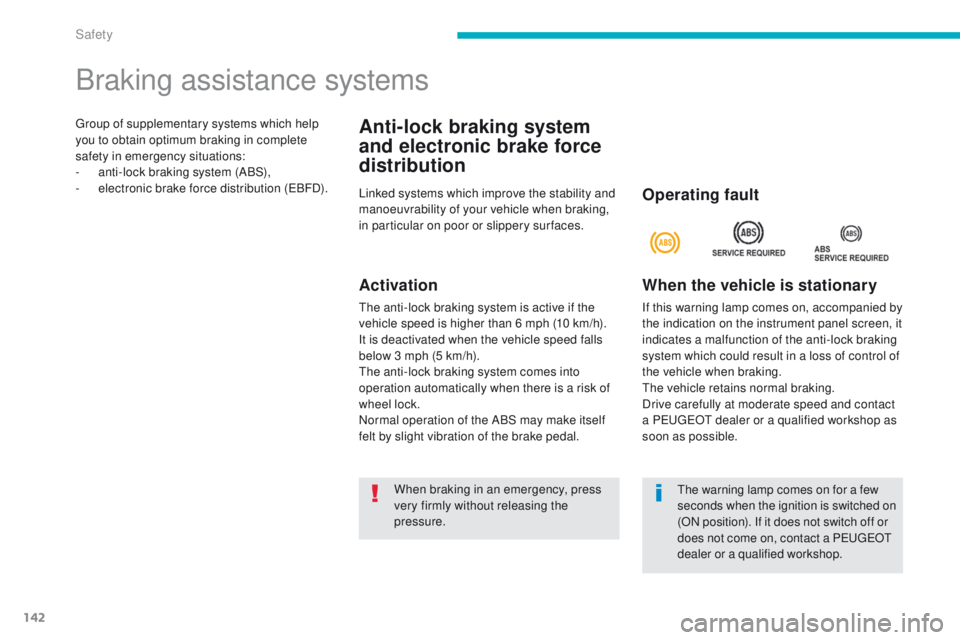
142
group of supplementary systems which help
you to obtain optimum braking in complete
safety in emergency situations:
-
a
nti-lock braking system (ABS),
-
e
lectronic brake force distribution (
eB
FD).
Braking assistance systems
Anti-lock braking system
and electronic brake force
distribution
Linked systems which improve the stability and
manoeuvrability of your vehicle when braking,
in particular on poor or slippery sur faces.
Activation
the anti-lock braking system is active if the
vehicle speed is higher than 6 mph (10 km/h).
It is deactivated when the vehicle speed falls
below 3
mph (5 km/h).
th
e anti-lock braking system comes into
operation automatically when there is a risk of
wheel lock.
Normal operation of the ABS may make itself
felt by slight vibration of the brake pedal.
Operating fault
When the vehicle is stationary
If this warning lamp comes on, accompanied by
the indication on the instrument panel screen, it
indicates a malfunction of the anti-lock braking
system which could result in a loss of control of
the vehicle when braking.
th
e vehicle retains normal braking.
Drive carefully at moderate speed and contact
a P
e
uge
Ot
dealer or a qualified workshop as
soon as possible.
When braking in an emergency, press
very firmly without releasing the
pressure.
th
e warning lamp comes on for a few
seconds when the ignition is switched on
(ON position). If it does not switch off or
does not come on, contact a P
e
uge
Ot
d
ealer or a qualified workshop.
Safety
Page 145 of 389
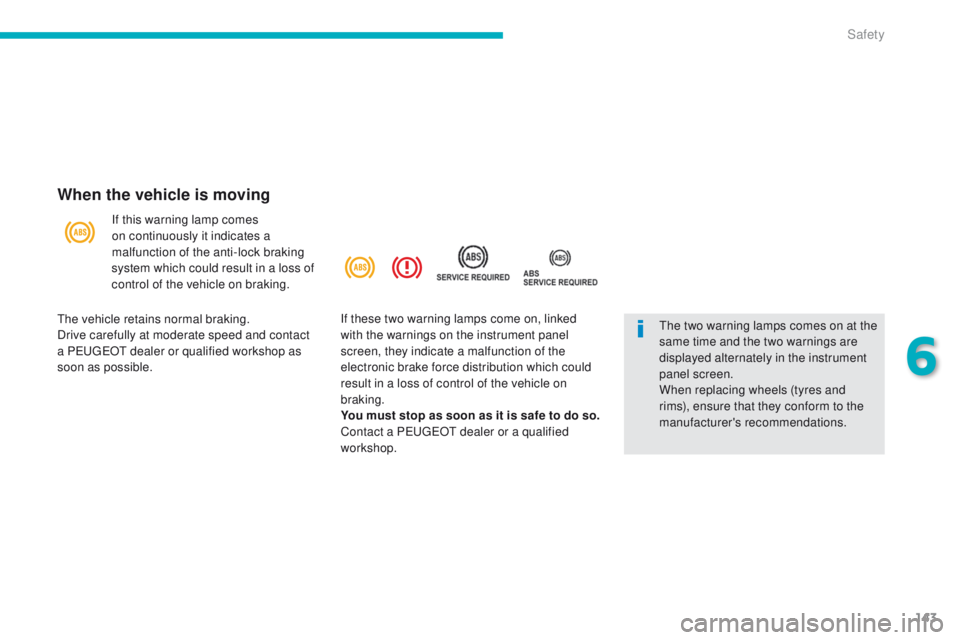
143
When the vehicle is moving
If this warning lamp comes
on continuously it indicates a
malfunction of the anti-lock braking
system which could result in a loss of
control of the vehicle on braking.
th
e two warning lamps comes on at the
same time and the two warnings are
displayed alternately in the instrument
panel screen.
When replacing wheels (tyres and
rims), ensure that they conform to the
manufacturer's recommendations.
th
e vehicle retains normal braking.
Drive carefully at moderate speed and contact
a P
e
uge
Ot
dealer or qualified workshop as
soon as possible. If these two warning lamps come on, linked
with the warnings on the instrument panel
screen, they indicate a malfunction of the
electronic brake force distribution which could
result in a loss of control of the vehicle on
braking.
You must stop as soon as it is safe to do so.
Contact a P
e
uge
Ot
dealer or a qualified
workshop.
6
Safety
Page 146 of 389
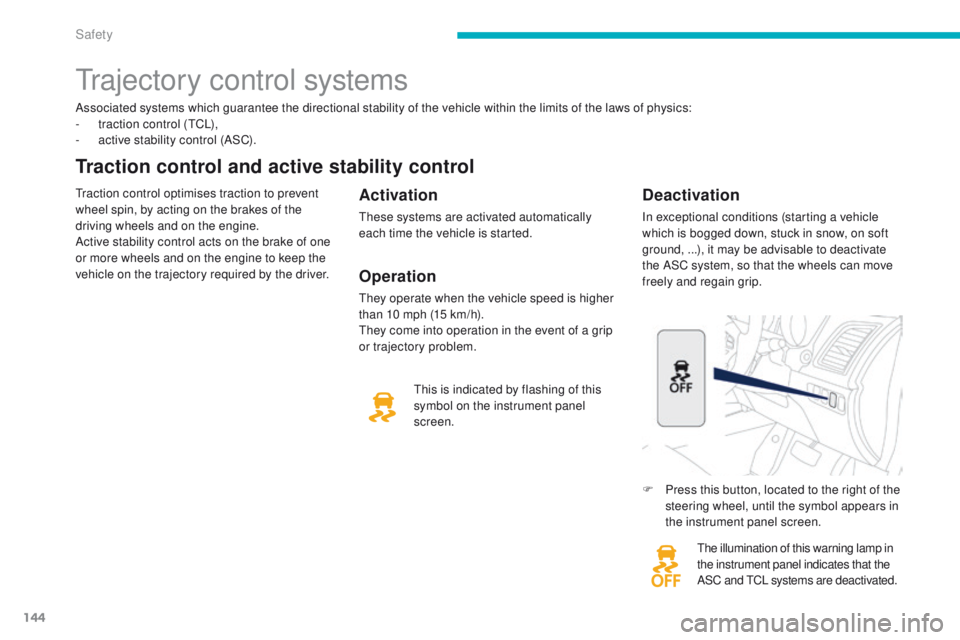
144
Associated systems which guarantee the directional stability of the vehicle within the limits of the laws of physics:
- t raction control (tC L),
-
a
ctive stability control (ASC).
Traction control and active stability control
traction control optimises traction to prevent
wheel spin, by acting on the brakes of the
driving wheels and on the engine.
Active stability control acts on the brake of one
or more wheels and on the engine to keep the
vehicle on the trajectory required by the driver.Activation
these systems are activated automatically
each time the vehicle is started.
th
e illumination of this warning lamp in
the instrument panel indicates that the
ASC and
t
C
L systems are deactivated.
Deactivation
In exceptional conditions (starting a vehicle
which is bogged down, stuck in snow, on soft
ground, ...), it may be advisable to deactivate
the ASC system, so that the wheels can move
freely and regain grip.
th
is is indicated by flashing of this
symbol on the instrument panel
screen.
trajectory control systems
F Press this button, located to the right of the steering wheel, until the symbol appears in
the instrument panel screen.
Operation
they operate when the vehicle speed is higher
than 10 mph (15 km/h).
th
ey come into operation in the event of a grip
or trajectory problem.
Safety
Page 147 of 389
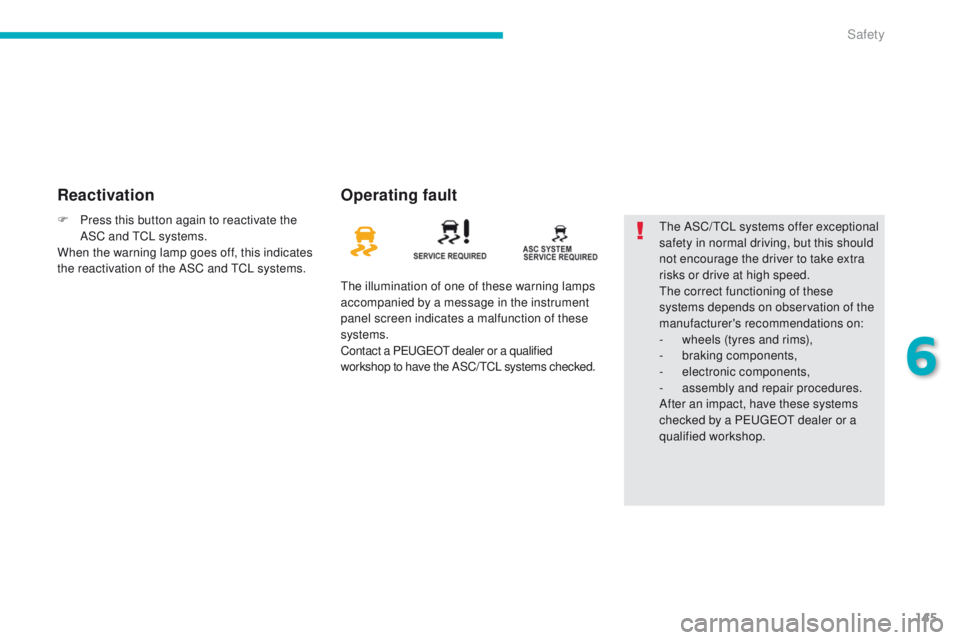
145
ReactivationOperating fault
the illumination of one of these warning lamps
accompanied by a message in the instrument
panel screen indicates a malfunction of these
systems.
Contact a P
e
uge
Ot
dealer or a qualified
workshop to have the ASC/
tC
L systems checked.
th
e ASC/
tC
L systems offer exceptional
safety in normal driving, but this should
not encourage the driver to take extra
risks or drive at high speed.th e correct functioning of these
systems depends on observation of the
manufacturer's recommendations on:
-
w
heels (tyres and rims),
-
b
raking components,
-
el
ectronic components,
-
a
ssembly and repair procedures.
After an impact, have these systems
checked by a P
e
uge
Ot
dealer or a
qualified workshop.
F
P
ress this button again to reactivate the
ASC and
t
C
L systems.
When the warning lamp goes off, this indicates
the reactivation of the ASC and
t
C
L systems.
6
Safety
Page 148 of 389
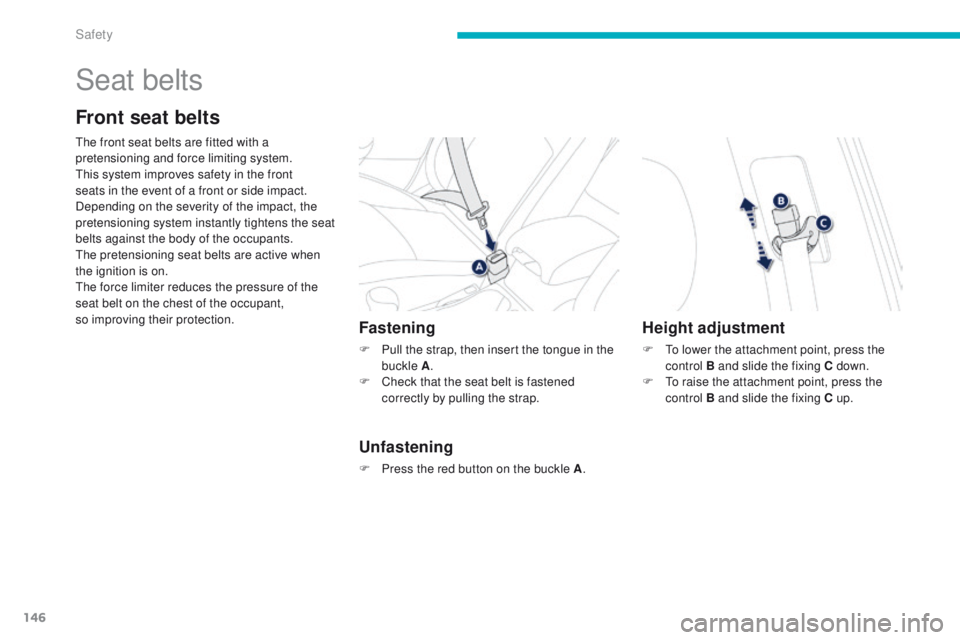
146
Seat belts
Front seat belts
the front seat belts are fitted with a
pretensioning and force limiting system.
th
is system improves safety in the front
seats in the event of a front or side impact.
Depending on the severity of the impact, the
pretensioning system instantly tightens the seat
belts against the body of the occupants.
the
pretensioning seat belts are active when
the ignition is on.
th
e force limiter reduces the pressure of the
seat belt on the chest of the occupant,
so improving their protection.
Fastening
F Pull the strap, then insert the tongue in the buckle A .
F
C
heck that the seat belt is fastened
correctly by pulling the strap.
Unfastening
F Press the red button on the buckle A .
Height adjustment
F to lower the attachment point, press the
control B and slide the fixing C down.
F
t
o r
aise the attachment point, press the
control B and slide the fixing C up.
Safety
Page 149 of 389
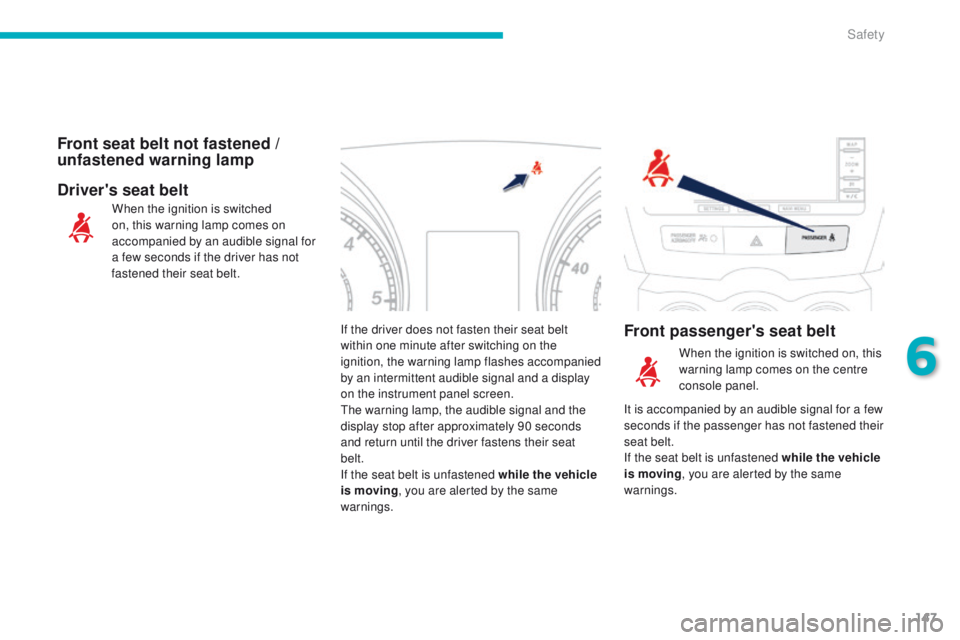
147
If the driver does not fasten their seat belt
within one minute after switching on the
ignition, the warning lamp flashes accompanied
by an intermittent audible signal and a display
on the instrument panel screen.
th
e warning lamp, the audible signal and the
display stop after approximately 90 seconds
and return until the driver fastens their seat
belt.
If the seat belt is unfastened while the vehicle
is moving , you are alerted by the same
warnings.
When the ignition is switched
on, this warning lamp comes on
accompanied by an audible signal for
a few seconds if the driver has not
fastened their seat belt.
Front seat belt not fastened /
u nfastened warning lamp
Front passenger's seat belt
Driver's seat belt
When the ignition is switched on, this
warning lamp comes on the centre
console panel.
It is accompanied by an audible signal for a few
seconds if the passenger has not fastened their
seat belt.
If the seat belt is unfastened while the vehicle
is moving , you are alerted by the same
warnings.
6
Safety
Page 150 of 389
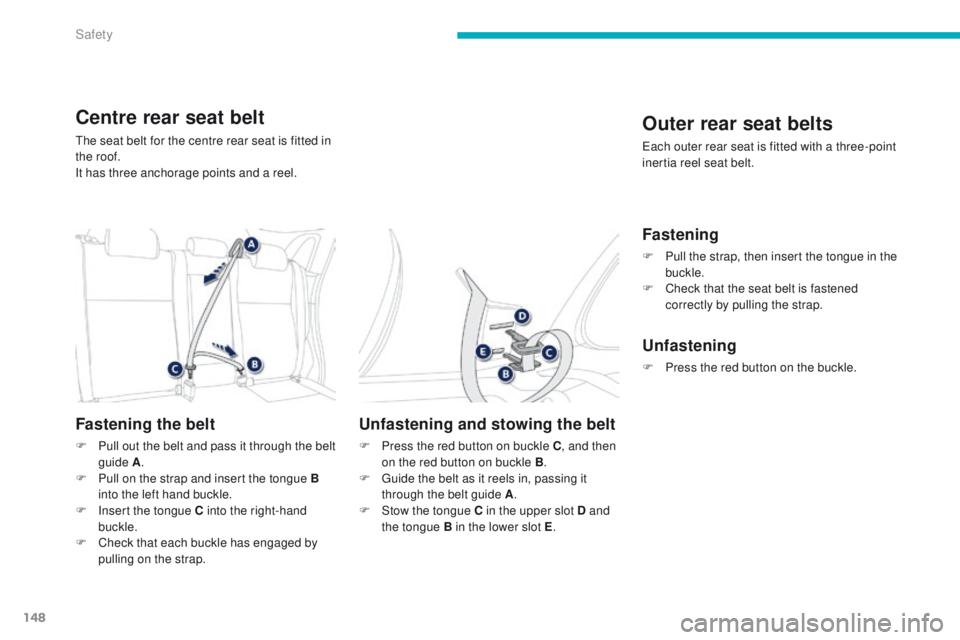
148
Centre rear seat belt
the seat belt for the centre rear seat is fitted in
the roof.
It has three anchorage points and a reel.
Fastening the belt
F Pull out the belt and pass it through the belt guide A .
F
P
ull on the strap and insert the tongue B
into the left hand buckle.
F
I
nsert the tongue C into the right-hand
buckle.
F
C
heck that each buckle has engaged by
pulling on the strap.
Unfastening and stowing the belt
F Press the red button on buckle C , and then
on the red button on buckle B .
F
g
u
ide the belt as it reels in, passing it
through the belt guide A .
F
S
tow the tongue C in the upper slot D and
the tongue B in the lower slot E .
Outer rear seat belts
each outer rear seat is fitted with a three-point
inertia reel seat belt.
Fastening
F Pull the strap, then insert the tongue in the
buckle.
F
C
heck that the seat belt is fastened
correctly by pulling the strap.
Unfastening
F Press the red button on the buckle.
Safety